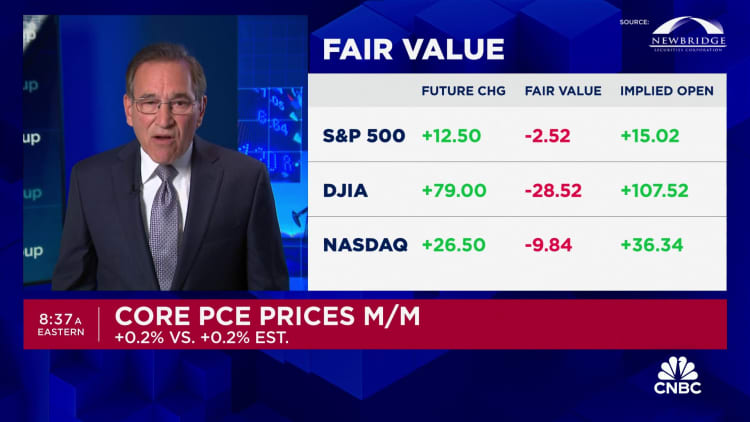
The Fed’s preferred inflation measure rose 0.2% in April, as expected
CNBC
The personal consumption expenditures price index excluding food and energy costs increased 0.2% in April and 2.8% from a year ago. Headline PCE rose 0.3% and 2.7%, respectively, in line with estimates. Personal income increased 0.3% on the month, matching the estimate, while spending rose just 0.2%.
Inflation rose about as expected in April, with markets on edge over when interest rates might start coming down, according to a measure released Friday that is followed closely by the Federal Reserve.
The personal consumption expenditures price index excluding food and energy costs increased just 0.2% for the period, in line with the Dow Jones estimate, the Commerce Department reported.
On an annual basis, core PCE was up 2.8%, or 0.1 percentage point higher than the estimate.
Including the volatile food and energy category, PCE inflation was at 2.7% on an annual basis and 0.3% from a month ago. Those numbers were in line with forecasts.
Fed officials prefer the PCE reading over the more closely followed consumer price index, which the Labor Department compiles. The Commerce Department measure accounts for changes in consumer behavior such as substituting less expensive items for costlier alternatives, and has a wider scope than the CPI.
“The core index came in at 2.8%. That’s fine, but it’s been trading in a range for five months now, and that’s pretty sticky to me,” said Dan North, senior economist for North America at Allianz Trade. “If I’m [Fed Chair Jerome] Powell, I’d like to see that start moving down, and it’s barely creeping. … I’m not reaching for the Pepto yet, but I’m not feeling great. This is not what you want to see.”
A 1.2% rise in energy prices helped push up the headline increase. Food prices posted a 0.2% decline on the month.
Goods prices rose 0.2% while services saw a 0.3% increase, continuing a normalization trend for an economy in which services and consumption provide much of the fuel.
Along with the inflation reading, Friday’s release included data about income and spending.
Personal income increased 0.3% on the month, matching the estimate, while spending rose just 0.2%, below the 0.4% estimate and off March’s downwardly revised 0.7%. Adjusted for inflation, the spending numbers showed a 0.1% decline, due in large part to a 0.4% decrease in spending
CNBC
The full article is available here. This article was published at CNBC Economics.
Comments are closed for this article!